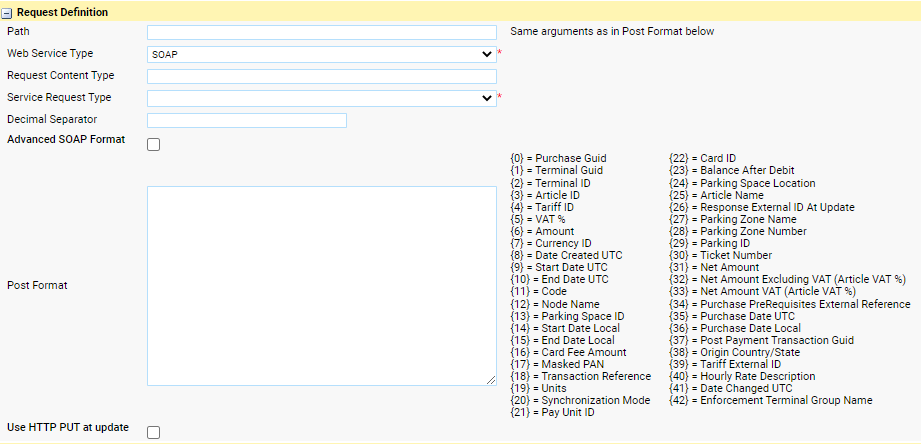Request definition

Figure 6, Create a Service Provider - step 2 - Request definition. Not all the Variables may be listed
Mandatory fields |
Attribute |
Explanation |
|---|---|---|
Request Definition |
||
Man. |
Path |
Path to the SOA service. Possible to use same arguments as in Post Format below |
Man. |
Web Service Type |
Type of web service, RESTor SOAP. |
Opt. |
Request Content Type |
Select content type. If empty, then content type "text/xml; charset=UTF-8" is used for SOAP |
Man. |
Service Request Type |
•XML |
Opt. |
Decimal Separator |
Decimal separator to be used in the request. |
Opt. |
Advanced SOAP format |
If checked the whole SOAP format must be specified including envelope, body and if needed headers. |
Man. |
Post Format |
Post format for the request. See SOA specifications Online Purchase Transfer. |
Opt. |
Use HTTP PUT at update |
Normally HTTP POST is used but if it is an update of an Ongoing Purchase it is possible to use HTTP PUT when accessing the SOA service. |
The Post Format shall have a format that match the Service Request Type
The {nn} variables will be replaced with data from the database when sending the request. The meaning of each variable is explained next to the Post Format box
It is possible to add fixed values to the request. See the JOSN example where e.g. the sellingPointID is set to WTP app.
Example in XML format
<m:OngoingPurchase xmlns:m="http://xxx.mipermit.net">
<m:Parking>
<m:PurchaseGuid>{0}</m:PurchaseGuid>
<m:TerminalGuid>{1}</m:TerminalGuid>
<m:TerminalID>{2}</m:TerminalID>
<m:ArticleID>{3}</m:ArticleID>
<m:TariffPackageID>{4}</m:TariffPackageID>
<m:VAT>{5}</m:VAT>
<m:Amount>{6}</m:Amount>
<m:Currency>{7}</m:Currency>
<m:CreateDate>{8}</m:CreateDate>
<m:StartDate>{9}</m:StartDate>
<m:EndDate>{10}</m:EndDate>
<m:Code>{11}</m:Code>
</m:Parking>
</m:OngoingPurchase>
Example in JSON format
{ "providerId": "Cale",
"transactionId": "{0}",
"productDescription": "Parking rights via Cale app",
"sellingPointId": "WTP app",
"sellingPointLocation": "{2}",
"areaManagerId": "KK",
"areaId": "{12}",
"vehicleId": "{11}",
"validityBegin": "{9}",
"validityEnd": "{10}",
"validityCancelled": false,
"validityHours": "0-24",
"prid": "{26}"
}
SOAP section

Figure 7, Create a Service Provider - step 2 - Request definition - SOAP section
Attribute |
Explanation |
Target Namespace |
Target namespace when SOAP protocol is used |
Method Name |
Method name for SOAP request. |
SOAP action |
SOAP action. If empty, then SOAP action Target Namespace + Method Name is used. |
Response definition
The response can be sent in 3 formats:

Figure 8, Create a Service Provider - step 3 - Response definition. Select service Response Type
•The HTTP option does not need any additional configuration
The table below the format images describes the fields available

Figure 9, Create a Service Provider - step 3 - Response definition XML
Attribute |
Explanation |
|---|---|
Response Definition |
|
Service Response Type |
HTTP Status Code JSON XML |
Response Node XPath |
XPath for response. |
Response External ID Attribute |
Name for attribute that contains external id for response. |
Response External Description Attribute |
Name for attribute that contains external description for response. |
Response Result Code Attribute |
Name for attribute that contains external code for response. |